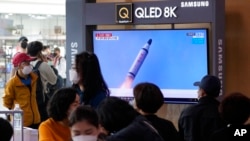North Korea has fired what appears to be a submarine-launched ballistic missile, South Korea’s military reported Saturday, the North’s 15th round of launches this year.
The short-range missile was launched Saturday afternoon from the Sinpo area toward the sea off North Korea’s east coast, South Korea’s Joint Chiefs of Staff said in an alert to reporters.
Japan’s coast guard also reported the launch, saying it appeared to be a ballistic missile that splashed down after about a 15-minute flight. Japan’s Kyodo news agency reported the missile flew for about 600 kilometers and landed outside Japan’s exclusive economic zone.
No further details were available. In the past, North Korea has launched SLBMs from the Sinpo South Shipyard using both an experimental ballistic missile submarine and a submersible test stand barge.
North Korea has ramped up missile tests this year, making significant progress on a weapons development wish list laid out in 2021 by leader Kim Jong Un.
On Friday, the U.S. State Department warned North Korea could also conduct another nuclear test as early as this month, noting recent preparations at the North’s main nuclear test site in the northeast part of the country. North Korea has not conducted a nuclear test in almost five years.
A nuclear explosion risks further raising tensions with North Korea’s neighbors, including its main economic backer, China, whose border is only about 160 kilometers from North Korea’s Punggye-ri nuclear test site.
However, China and Russia have largely looked the other way as Pyongyang ramps up missile tests. Instead, Beijing and Moscow have pressured the United States to do more to restart nuclear talks that have not been held since 2019.
The United States has repeatedly said it is willing to reenter negotiations without preconditions, but North Korea has either rejected or ignored those invitations. Instead, it has fired missiles, sometimes at a record pace. In late March, the North conducted its first long-range launch in over four years.
The North’s apparent launch Saturday comes just three days after its previous missile test on Wednesday, which uncharacteristically went unreported in North Korean state media the following day.
“That suggested the Kim regime wanted to keep its progress secret or didn’t want to admit to a failed test,” said Leif-Eric Easley, associate professor of international studies at Ewha Womans University in Seoul.
“Either way, it was apparent Pyongyang would conduct another test soon,” he said.
North Korea has multiple possible reasons for launching missiles.
While Western media reports and U.S. officials often describe the launches as “provocations,” there is an increasing amount of evidence that the North is instead focused on the military dimension of such tests.
“Some observers suggest that North Korea launches missiles to get Washington’s attention and restart dialogue. There is more evidence that Pyongyang is focused on improving military capabilities to deter, threaten and extort other countries,” said Easley.
Last week, Kim warned he could “preemptively” use his country’s nuclear weapons to counter hostile forces, if necessary. At a military parade in late April, Kim also warned that his nuclear forces were tasked not only with deterring the country’s enemies but also striking anyone who violates the North’s “fundamental interests.”
The comments have raised concerns that Kim may use the threat of a nuclear attack to coerce his neighbors, in some ways mirroring the strategy of Russian President Vladimir Putin, who has regularly threatened a nuclear attack in Ukraine.
The tensions come as South Korea prepares to inaugurate a new conservative president, former chief prosecutor Yoon Suk-yeol, who has promised to take a tougher approach toward the North.
Yoon, who takes office on Tuesday, has vowed to fully restore joint military exercises with the United States that have been scaled back or spread out since 2018 to preserve diplomacy and because of the coronavirus pandemic.









